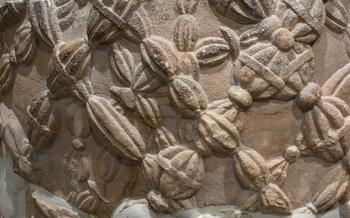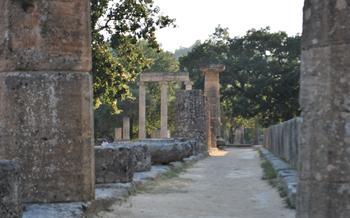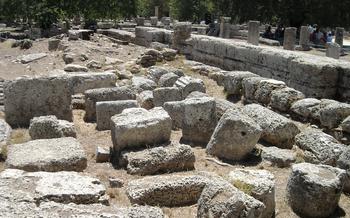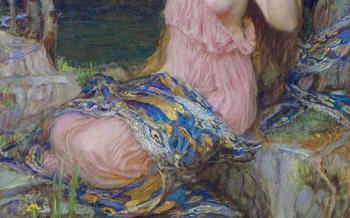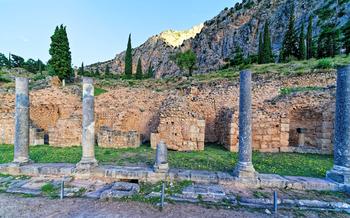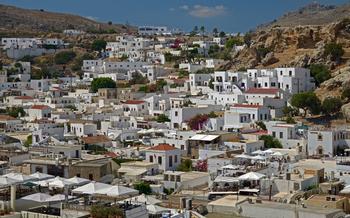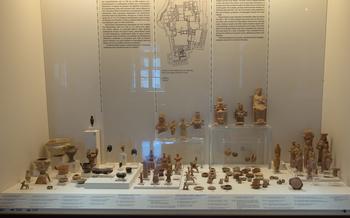
Pleuron's Acropolis
- The Antiquity of Pleuron's Acropolis : Historical Background and Significance
- Exploring the Ruins
- The Temple of Apollo
- The Views from the Acropolis
- The Archaeological Museum of Pleuron
- Best Time to Visit
- Getting There
- Hiking and Nature Trails
- Local Cuisine and Dining
- Accommodation Options:
- Tips for Photography Enthusiasts
- Family-Friendly Activities
- Historical and Cultural Significance
- Combining with Other Attractions
- Insider Tip: Unearthing Hidden Treasures
The Antiquity of Pleuron's Acropolis : Historical Background and Significance
Pleuron's Acropolis stands as a testament to the rich history and cultural heritage of ancient Greece. It was once a flourishing city-state, dating back to the Mycenaean period around 1400 BC. The site holds immense historical significance as it played a pivotal role in the development of the region. Pleuron was a member of the Aetolian League, a powerful alliance of city-states in ancient Greece, and served as a vital strategic and economic center.
The city flourished during the Classical and Hellenistic periods, reaching its peak in the 4th century BC. It was known for its impressive fortifications, temples, and public buildings, which reflected the wealth and prosperity of the city. In the 2nd century BC, Pleuron was conquered by the Romans and incorporated into the Roman Empire. Despite its decline, the city's legacy lived on, as it remained an important religious and cultural center throughout antiquity.
Exploring the Ruins
Ascending the ancient pathways of Pleuron's Acropolis, you will encounter an array of fascinating ruins that speak to the city's rich history. Explore the remnants of mighty fortifications that once protected the acropolis from invaders. These towering walls, constructed with precision and strength, offer a glimpse into the defensive strategies of ancient Pleuron.
Amidst the ruins, uncover the sacred spaces where the city's inhabitants worshipped their deities. Temples and sanctuaries dedicated to various gods and goddesses, including Apollo, Artemis, and Athena, stand as testaments to the religious devotion of the ancient Pleurians. Admire the architectural details and intricate carvings that adorned these sacred sites, offering a glimpse into the spiritual beliefs and practices of the past.
Venture beyond the religious sanctuaries to discover the remnants of public buildings and residential areas. Explore the foundations of administrative structures, marketplaces, and theaters, where the citizens of Pleuron conducted their daily affairs. Imagine the bustling streets filled with merchants, artisans, and philosophers engaging in lively discussions and commerce.
As you wander through the ruins, let your imagination transport you back in time to witness the vibrant life that once thrived within the walls of Pleuron's Acropolis. Each stone and fragment holds a story, waiting to be discovered and pieced together, revealing the tapestry of this ancient city's past.
The Temple of Apollo
Among the ruins of Pleuron's Acropolis, the Temple of Apollo stands as a testament to the city's religious devotion and connection to the divine. Constructed in the 6th century BC, the temple's Doric architectural style reflects the influence of mainland Greece and its proximity to the Peloponnese. Its well-preserved columns and pediments hint at the grandeur it once possessed.
The temple served as a sacred sanctuary dedicated to Apollo, the Greek god of music, prophecy, and healing. Devotees would gather here to seek guidance, offer prayers, and participate in religious rituals. Archaeologists have uncovered evidence of altars, votive offerings, and inscriptions that shed light on the temple's significance as a religious center.
The Temple of Apollo is not only a testament to ancient Greek religious practices but also a symbol of Pleuron's connection to the Oracle of Delphi. As a member of the Delphic Amphictyony, a religious league centered around the Oracle, Pleuron played a crucial role in maintaining the sacred site and ensuring its influence throughout the Greek world.
The Views from the Acropolis
The Pleuron's Acropolis offers breathtaking panoramic vistas of the surrounding landscape, making it a popular destination for nature enthusiasts and photographers alike. From the summit of the hill, visitors can enjoy uninterrupted views of the lush green valleys, rolling hills, and distant mountain ranges. On a clear day, the sparkling waters of the Gulf of Patras and the Ionian Sea stretch out to the horizon, creating a mesmerizing backdrop.
As the sun begins to set, the sky transforms into a canvas of vibrant colors, casting a magical glow over the ancient ruins. The golden hues of the sunset illuminate the surrounding landscape, creating a truly unforgettable spectacle. As darkness descends, the Acropolis becomes an ideal spot for stargazing. The clear night sky reveals a myriad of stars and constellations, providing a celestial show that is sure to captivate visitors of all ages.
The Archaeological Museum of Pleuron
The Archaeological Museum of Pleuron, located near the ancient acropolis, is a treasure trove of artifacts and exhibits that provide a fascinating glimpse into the history and culture of ancient Pleuron. The museum houses a collection of pottery, sculptures, jewelry, tools, and other artifacts excavated from the acropolis and its surroundings. Visitors can explore displays that showcase the Mycenaean, Classical, and Hellenistic periods, offering a comprehensive understanding of Pleuron's rich cultural heritage. Interactive displays and educational programs bring the ancient world to life, making the museum an engaging and informative experience for visitors of all ages.
Best Time to Visit
The best time to visit Pleuron's Acropolis is during the spring (April-May) and autumn (September-October) when the weather is pleasant and mild, with warm days and cool nights. The summer months (June-August) can be hot and crowded, especially during the peak tourist season. If you prefer a more peaceful experience, consider visiting during the shoulder seasons (May-June and September-October).
During the winter months (November-March), the Acropolis is still accessible, but some areas may be closed due to weather conditions. However, the views from the top can be breathtaking, especially on a clear day.
Insider Tip: For a truly unique experience, visit the Acropolis during the annual Pleuron Festival, held in July. The festival celebrates the history and culture of ancient Pleuron and features traditional music, dance, food, and reenactments of ancient rituals.
Getting There
Reaching Pleuron's Acropolis is a breeze, with various transportation options available to suit your needs. Whether you prefer a scenic drive, a comfortable bus ride, or a guided tour, you'll find it easy to get to this ancient wonder.
For those who enjoy road trips, driving from major cities like Athens or Thessaloniki is a great way to soak in the breathtaking Greek countryside. Just follow the well-maintained roads and enjoy the changing landscapes along the way. Once you arrive, ample parking space is available near the Acropolis, ensuring a hassle-free visit.
If you prefer a more relaxed journey, hop on a comfortable bus from Athens or Patras. These buses offer a convenient and affordable way to travel, and they drop you off right at the foot of the Acropolis.
For a more immersive experience, consider joining a guided tour or organized excursion. These tours often combine a visit to Pleuron's Acropolis with other nearby attractions, such as the ancient city of Delphi or the picturesque villages of the Peloponnese. With an experienced guide leading the way, you'll gain valuable insights into the history and significance of these sites.
Hiking and Nature Trails
Discover the Enchanting Landscapes Surrounding Pleuron's Acropolis
Pleuron's Acropolis is not only a treasure trove of ancient ruins but also a gateway to breathtaking natural beauty. The surrounding countryside beckons with a network of scenic trails, inviting you to explore the diverse landscapes that have captivated visitors for centuries.
Starting from the Acropolis, you can embark on a leisurely stroll through olive groves, where the rustling leaves create a soothing melody. As you ascend the gentle slopes, the panorama unfolds, revealing rolling hills, lush valleys, and distant mountain peaks.
For a more adventurous experience, venture into the forested areas surrounding the Acropolis. Here, you'll find well-marked trails that wind through dense vegetation, offering glimpses of hidden waterfalls, crystal-clear streams, and a rich diversity of flora and fauna.
Along the way, keep an eye out for the local wildlife. The region is home to a variety of birds, including eagles, hawks, and owls. You may also encounter friendly reptiles like lizards and turtles basking in the sun.
Whether you're a seasoned hiker looking for a challenging trek or a nature enthusiast seeking a tranquil escape, the surroundings of Pleuron's Acropolis offer something for everyone. Take a break from exploring ancient ruins and immerse yourself in the beauty of the natural world.
Local Cuisine and Dining
Savor the Delights of Greek Gastronomy in Pleuron
Indulge your taste buds with the delectable flavors of traditional Greek cuisine, a harmonious blend of fresh ingredients, aromatic herbs, and centuries-old culinary traditions.
-
Must-Try Dishes: Begin your culinary journey with moussaka, a hearty casserole of eggplant, potatoes, ground beef, and béchamel sauce, a dish that has captivated hearts and palates for generations. Don't miss the chance to savor the simplicity yet deliciousness of souvlaki, succulent skewers of grilled meat, or the tangy zest of dolmades, savory vine leaves stuffed with rice, herbs, and minced meat.
-
Recommended Restaurants: Nestled amidst the charming streets of Pleuron, you'll find a selection of tavernas and restaurants that will tantalize your senses with their authentic flavors. For a taste of traditional Greek cooking, head to Taverna To Kyma, known for its mouthwatering seafood dishes and stunning views of the Gulf of Patras. To Steki tou Ilia offers a delightful ambiance and a menu that celebrates the culinary heritage of the region.
-
Picnic Spots: Embrace the natural beauty of Pleuron and enjoy a delightful picnic amidst the picturesque landscapes. Pack a basket filled with fresh fruits, artisanal cheeses, crusty bread, and a bottle of local wine. Find a shady spot beneath an olive tree or along the scenic trails, and savor the flavors of Greece while immersed in the tranquility of nature.
Accommodation Options:
For those seeking a comfortable and convenient stay near Pleuron's Acropolis, a range of accommodation options awaits. Quaint hotels and guesthouses nestled in charming villages offer authentic Greek hospitality and easy access to the ancient site. For a more immersive experience, consider camping or glamping amidst the stunning natural surroundings. Set up your tent or cozy glamping pod and enjoy the tranquility of the countryside under a canopy of stars. Airbnb and vacation rentals provide another excellent option, allowing travelers to immerse themselves in the local culture while enjoying the comforts of a home away from home. Whether you prefer the convenience of a hotel, the charm of a guesthouse, the adventure of camping, or the privacy of a vacation rental, you'll find the perfect place to rest and recharge after a day of exploring Pleuron's Acropolis and the surrounding area.
Tips for Photography Enthusiasts
Pleuron's Acropolis offers a treasure trove of photographic opportunities for enthusiasts of all levels. With its ancient ruins, stunning views, and natural beauty, the site provides endless possibilities for capturing breathtaking images.
To make the most of your photographic experience, consider these tips:
-
Golden Hour Magic: Plan your visit during the golden hours of sunrise and sunset to capture the warm, diffused light that enhances the textures and colors of the ruins.
-
Experiment with Angles: Don't be afraid to experiment with different angles and perspectives. Climb to the highest point of the Acropolis for panoramic shots or get up close to capture the intricate details of the ancient stones.
-
Use Natural Light: Take advantage of the natural light to create dramatic shadows and highlights. Position yourself so that the sun illuminates the ruins, creating a sense of depth and dimension.
-
Play with Composition: Use the elements of composition, such as leading lines, symmetry, and framing, to create visually appealing images. Incorporate the surrounding landscape, such as the mountains or the sea, to add context and depth to your shots.
-
Try Black and White: Consider converting your images to black and white to create a timeless and evocative feel. Black and white photography can emphasize the textures and forms of the ruins, creating a sense of mystery and nostalgia.
-
Use a Tripod: For sharp and stable images, especially in low-light conditions, use a tripod to steady your camera. This will allow you to capture long exposure shots, capturing the movement of clouds or stars, and creating stunning effects.
-
Join a Photography Tour: To enhance your experience and learn from experts, consider joining a photography tour or workshop. These tours often provide guidance on composition, lighting, and post-processing techniques, helping you take your photography skills to the next level.
Family-Friendly Activities
Visiting the Pleuron's Acropolis can be a fun and educational experience for families with children of all ages. The archaeological museum offers interactive exhibits and workshops designed to engage young minds and bring history to life. Storytelling sessions and educational programs immerse children in the myths and legends of ancient Greece, making learning about the past an exciting adventure. Picnic areas and playgrounds provide opportunities for families to relax and enjoy the outdoors while taking in the stunning views from the Acropolis. With its blend of history, nature, and family-friendly activities, the Pleuron's Acropolis offers a unique and memorable experience for visitors of all ages.
Historical and Cultural Significance
Pleuron's Acropolis holds immense historical and cultural significance, offering a glimpse into the rich tapestry of ancient Greek civilization. The site has been continuously inhabited since the Mycenaean period, with evidence of settlements dating back to the 14th century BC. During the Classical period, Pleuron emerged as a powerful city-state, playing a pivotal role in the Peloponnesian War and other conflicts. The city's strategic location along trade routes and its control over the fertile plains of Aetolia contributed to its prosperity and influence.
In the Hellenistic period, Pleuron came under the rule of the Aetolian League, a powerful confederation of city-states. During this time, the city experienced a period of cultural and artistic flourishing, as evidenced by the construction of impressive temples, theaters, and other public buildings. The remains of these structures, along with numerous artifacts discovered during archaeological excavations, provide valuable insights into the daily life, religious practices, and political systems of ancient Pleuron.
Throughout its history, Pleuron has been a melting pot of cultures, absorbing influences from neighboring regions such as Epirus, Macedonia, and Central Greece. The city's strategic location at the crossroads of major trade routes facilitated the exchange of goods, ideas, and artistic styles, contributing to the rich cultural heritage of the region. Ongoing archaeological research and excavations continue to uncover new evidence of Pleuron's fascinating past, shedding light on the city's role in shaping the course of ancient Greek history.
Combining with Other Attractions
Pleuron's Acropolis is not just an isolated site but is part of a rich cultural and historical tapestry. Take advantage of your visit to explore nearby attractions that will enhance your understanding of the region's past. Just a short drive away, you can visit the ancient city of Thermos, home to the Sanctuary of Apollo Thermios and a well-preserved theater. Immerse yourself in the legacy of the Oracle of Delphi by visiting the renowned Delphi Archaeological Museum, showcasing artifacts from the sacred site.
Extend your journey with a scenic drive along the picturesque coast, stopping at charming villages and hidden beaches. Discover the medieval wonders of Nafpaktos, a historic port town with a Venetian fortress and narrow cobbled streets. Continue south to the Peloponnese, where ancient ruins, such as the Temple of Zeus at Olympia, await exploration. With its central location, Pleuron's Acropolis serves as an ideal starting point for a captivating exploration of Greece's diverse heritage.
Insider Tip: Unearthing Hidden Treasures
Beyond the main attractions of Pleuron's Acropolis, there are hidden gems waiting to be discovered. Venture off the beaten path and explore the lesser-known corners of the site. Seek out the ancient theater, nestled amidst the ruins, where performances and gatherings once took place. Discover the remains of the city's water system, a testament to the ingenuity of ancient engineers. Keep an eye out for hidden inscriptions and carvings on stones, offering glimpses into the lives and beliefs of the people who inhabited this place centuries ago.
Embrace the local traditions and immerse yourself in the vibrant culture of the region. Attend a traditional Greek festival, where you can witness lively music, dancing, and delicious food. Engage with the friendly locals, who are always eager to share stories and insights about their heritage.
Don't miss the opportunity to pick up unique souvenirs and handicrafts as mementos of your visit. From intricate pottery and woven textiles to hand-painted ceramics, you'll find an array of treasures to take home. Support local artisans and craftsmen by purchasing their creations, contributing to the preservation of traditional skills and cultural heritage.
